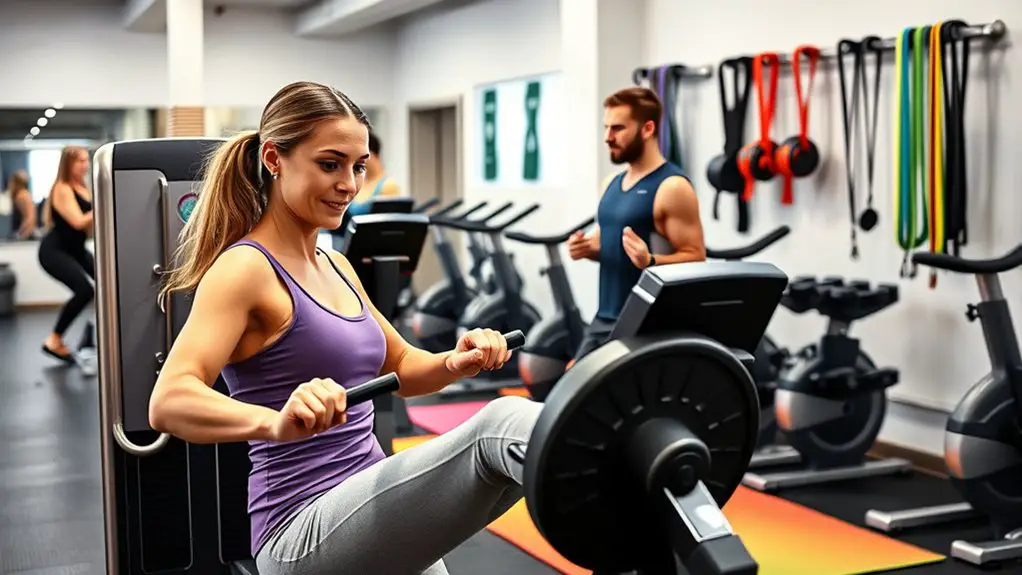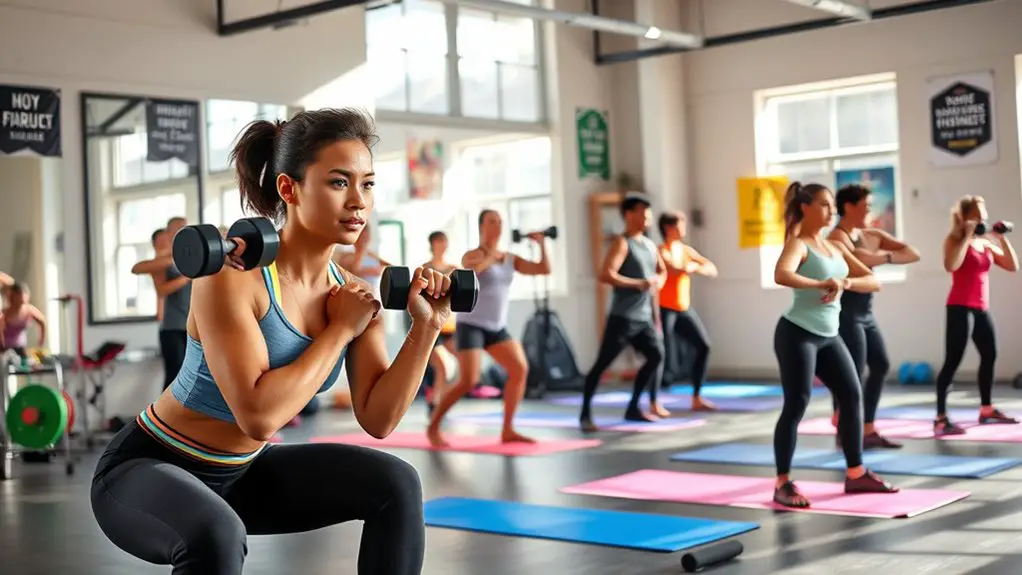Best Gym Workouts for Beginners

The best gym workouts for beginners focus on full-body routines, cardio exercises, and strength training. Start with machines that guide movements and incorporate basic exercises like squats, push-ups, and planks. Mix in steady-state cardio, like jogging or cycling, to build endurance. Aim for three full-body workouts a week and prioritize recovery to avoid injury. Consistency is key to building a sustainable habit, and there’s more you can explore to enhance your fitness journey.
Understanding Gym Equipment Basics

When stepping into a gym for the first time, the array of equipment can feel overwhelming. To make your experience safer and more enjoyable, it’s essential to understand the different gym equipment types. You’ll find machines like treadmills, stationary bikes, and weight machines, each designed for specific workouts. Start with machines that guide your movements, as they often have built-in safety features.
Before using any equipment, take a moment to read the instructions and adjust settings to fit your body. Always warm up to prevent injuries, and don’t hesitate to ask gym staff for assistance if you’re unsure how to use something. Remember, safety precautions are key—wear proper footwear, and avoid lifting weights that feel too heavy. By getting familiar with gym equipment basics, you’ll build confidence and create a safer workout environment for yourself. Additionally, focusing on form is crucial to prevent injury as you become accustomed to the equipment.
Full-Body Workouts for Beginners
When you’re starting out, full-body workouts are a great way to build strength and endurance. You’ll want to focus on key exercises that target multiple muscle groups, and knowing how often to work out can make a big difference in your progress. Plus, mastering proper form from the beginning will help you avoid injuries and get the most out of your sessions. Additionally, ensuring that you reach 60-80% of maximum heart rate during workouts can significantly enhance your fitness results.
Key Full-Body Exercises
Starting your fitness journey can be exciting, especially when you incorporate key full-body exercises into your routine. Focus on compound movements like squats, deadlifts, and push-ups, as they engage multiple muscle groups, making your workouts efficient. Bodyweight exercises are a fantastic option for beginners, allowing you to build strength without the need for equipment. Incorporate planks and lunges to enhance stability and flexibility. Remember to start with lighter weights or modify movements to guarantee you’re practicing safely. It’s vital to pay attention to your form to prevent injuries. As you progress, you can gradually increase intensity and complexity. Embrace these foundational exercises, and you’ll create a solid base for your fitness journey!
Workout Frequency Recommendations
Finding the right workout frequency is vital for beginners aiming to build a solid foundation in fitness. A common recommendation is to start with a full-body workout split three times a week. This allows you to engage all major muscle groups while also providing adequate recovery days in between sessions. For instance, you might work out on Monday, Wednesday, and Friday, giving your body time to recover and adapt. Remember, it’s important not to rush; listen to your body and take extra rest days if you’re feeling fatigued or sore. Gradually increase intensity and frequency as you become more comfortable and confident in your routine. Prioritizing safety will help guarantee you stick with your fitness journey long-term.
Proper Form Techniques
While mastering proper form techniques is essential for beginners, it can greatly enhance your workout experience and prevent injuries. Focus on maintaining proper posture throughout your exercises, as this can prevent common mistakes that lead to strain or injury.
| Common Mistakes | Proper Techniques |
|---|---|
| Rounding your back | Keep your spine straight |
| Locking your joints | Maintain a slight bend |
| Overextending limbs | Control your range of motion |
| Not engaging your core | Tighten your abdominal muscles |
| Skipping warm-ups | Always start with a warm-up |
Cardio Exercises to Boost Endurance
When you’re looking to boost your endurance, incorporating various types of cardio workouts is key. You’ll want to contemplate the right duration and intensity to maximize your results. Let’s explore how to structure your cardio routine effectively. Skipping rope is an excellent option for reducing belly fat while also improving overall fitness.
Types of Cardio Workouts
Cardio workouts are essential for beginners looking to boost their endurance and overall fitness. Two popular types are steady state cardio and high intensity interval training (HIIT). Steady state cardio involves maintaining a consistent pace, like jogging or cycling, for an extended time. It’s great for building a solid foundation and improving heart health without overwhelming your body. On the other hand, HIIT alternates between short bursts of intense activity and rest periods. This method can be more efficient, helping you burn calories and improve endurance in a shorter time. Always start slow, listen to your body, and make sure to warm up and cool down properly. This way, you’ll stay safe while enjoying your cardio journey!
Duration and Intensity Guidelines
To maximize the benefits of your cardio workouts, it’s important to understand the right duration and intensity levels. For beginners, aim for 150 minutes of moderate-intensity cardio per week, which you can break down into shorter sessions, like 30 minutes a day, five times a week. This is a great duration strategy to build endurance safely.
Start with a comfortable intensity level—think of a brisk walk or light jogging. As you get used to the workouts, gradually increase the intensity by incorporating intervals or increasing your pace. Remember, it’s essential to listen to your body and adjust your duration and intensity based on how you feel. This way, you’ll stay motivated and safe while improving your endurance.
Strength Training Essentials

While starting your fitness journey, understanding the essentials of strength training can make a significant difference in your progress. Strength training offers numerous benefits, such as increased muscle mass, improved metabolism, and enhanced overall strength, which are essential for your long-term health. To get started safely, focus on mastering the basic movements like squats, deadlifts, and bench presses.
Begin with lighter weights to guarantee proper form, as this will prevent injuries and build a solid foundation. It’s important to listen to your body; if something doesn’t feel right, don’t hesitate to adjust your approach. Incorporating clean and press alternatives can provide variety and help maintain proper form while still working on strength. Incorporate beginner workout tips, such as setting realistic goals and gradually increasing your weights. Finally, remember to prioritize recovery by allowing your muscles time to heal and grow. With patience and consistency, you’ll reap the strength training benefits and set yourself up for lasting success.
Flexibility and Mobility Routines
Incorporating flexibility and mobility routines into your workout plan is essential for enhancing your overall performance and preventing injuries. These practices help improve your range of motion, making your workouts more effective and safer.
Incorporating flexibility and mobility routines is vital for improving performance and preventing injuries in your workouts.
Here are some simple routines to take into account:
- Dynamic stretching before workouts to warm up your muscles and joints.
- Foam rolling to release muscle tightness and improve blood flow.
- Static stretching post-workout to help your muscles recover and lengthen.
- Yoga or Pilates sessions to enhance flexibility and core strength.
- Mobility drills targeting specific joints, like hips and shoulders, for better movement.
Creating a Consistent Workout Schedule

Creating a consistent workout schedule is essential for achieving your fitness goals, especially as a beginner. To make your workouts safe and effective, start by setting realistic, achievable goals. Use motivational strategies like tracking your progress and rewarding yourself for sticking to your schedule.
Next, focus on time management. Determine how many days a week you can commit to exercising and block out those times in your calendar, just like any important appointment. Consider mixing different workouts to keep things interesting and manageable, ensuring you include rest days to allow your body to recover.
Consistency is key, so find a time that works best for you—whether it’s early morning or after work. Remember, it’s about building a habit, not pushing your limits too quickly. Additionally, be sure to prioritize recovery and rest to prevent injuries and maintain long-term progress. By following these tips, you’ll create a sustainable workout routine that keeps you motivated and safe on your fitness journey.
Frequently Asked Questions
How Do I Stay Motivated to Work Out Regularly?
Staying motivated to work out regularly can be challenging, but you can make it easier. Consider finding workout buddies who share your fitness goals; they’ll keep you accountable and make exercising more enjoyable. Setting realistic milestones can also help you stay focused and celebrate progress along the way. Remember to prioritize safety by listening to your body and choosing exercises that suit your fitness level. Keep it fun, and you’ll stick with it!
What Should I Eat Before and After Workouts?
When it comes to fueling your fitness journey, think of pre workout snacks as delightful little boosters. A banana or a handful of nuts can work wonders. After you’ve crushed your workout, treat yourself to nourishing post workout meals like a protein-packed smoothie or grilled chicken with veggies. These choices not only support your body’s recovery but also keep you feeling energized and safe as you continue on your path to health.
How Can I Track My Progress Effectively?
To track your progress effectively, consider using progress journals or fitness apps. A progress journal lets you log workouts, nutrition, and feelings, helping you see improvements over time. Fitness apps can offer features like tracking exercises, monitoring weight, and setting goals, making it easier to stay motivated. Always remember to listen to your body and adjust your routine for safety. Regularly reviewing your data can keep you on the right path to your fitness goals.
Is It Safe to Work Out Every Day?
Imagine your body as a garden. Just like flowers need sunlight and water, you need rest days to flourish. Working out every day might sound tempting, but without those vital breaks, you risk burning out or injuring yourself. Think of workout frequency as a rhythm; it’s essential to find balance. Incorporating rest days into your routine helps you cultivate strength and resilience, allowing your garden to thrive and bloom beautifully over time.
What Should I Wear to the Gym?
When you’re heading to the gym, choosing the right gym attire is essential for comfort and safety. Opt for moisture-wicking fabrics that allow your skin to breathe and help keep you dry during workouts. Don’t forget about your workout shoes; they should offer good support and cushioning to protect your feet. Proper attire not only enhances your performance but also minimizes the risk of injury, so make sure you’re well-prepared!





